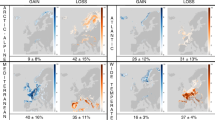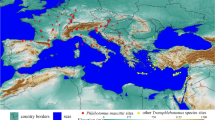Abstract
The objective of this exploratory work is to test the hypothesis that South American populations of Ophioglossum reticulatum L. derive from Africa. Spores cross the Atlantic transported by wind and arrive in South America in recurrent migration. Three-dimensional (backward and forward) trajectories of spores between Africa and South America were calculated using the Hybrid Single Particle Lagrangian Integrated Trajectory Model (HYSPLIT4). The model showed possible backward trajectories in the low troposphere arriving in South America with probable origin in Northwestern Africa. The results support the hypothesis of long-distance dispersal of the studied species. Including vertical motion in the model runs allowed obtaining valuable and novel information about the migration routes. The trade winds combined with the South American monsoon could be a dispersal vehicle for the disseminules from Northwestern Africa to the eastern slopes of the Andes. As the monsoon is a periodic regional atmospheric circulation pattern, transcontinental migration can be assumed to be a recurring phenomenon that provides genetic exchange and prevents speciation by reproductive isolation. Modelled forward trajectories connect the neotropics with Africa-Madagascar, but they seem to be less effective due to their travelling altitudes. This hypothesis might explain the absence of infraspecific taxa restricted to different geographic locations.










Similar content being viewed by others

References
Allan HH (1961) Flora of New Zealand, 1st edn. Government Printer, Wellington
Arya SP (1999) Air pollution meteorology and dispersion. Oxford University Press, New York
Barrington DS (1993) Ecological and historical factors in fern biogeography. J Biogeogr 20:275–280
Bianchi MM (1994) El Muestreo Aerobiológico en Mar del Plata. Aportes de Una Nueva Metodología Al Análisis de Polen. Su Aplicación en El Diagnóstico de la Polinosis. Monografía N° 10. Academia Nacional de Ciencias, Buenos Aires
Brum FR, Randi AM (2002) High irradiance and temperature inhibit the germination of spores of the fern Rumohra adiantiformis (Forst.) Ching (Dryopteridaceae). Revista Brasil Bot 25:391–396
Cabezudo B, Recio M, Sanchez-La JM (1997) Atmospheric transportation of marihuana pollen from North Africa to the southwest of Europe. Atmos Environ 31:3323–3328
Carlson TN (1998) Mid-latitude weather systems. American Meteorological Society, Boston, p 507
Clausen RT (1938) A monograph of the Ophioglossaceae. Mem Torrey Bot Club 19:1–177
De la Sota ER (1977) Pteridofitas. In: Cabrera AL (ed) Flora de la Provincia de Jujuy, 8th edn. Colección Científica del Instituto Nacional de Tecnología Agropecuaria, Buenos Aires, pp 1–275
De la Sota ER, Ponce MM (2008) Ophioglossaceae. In: Zuloaga FO, Morrone O, Belgrano MJ (eds) Catálogo de plantas Vasculares del Cono Sur (Argentina, Sur de Brasil, Chile y Uruguay. Monogr Syst Bot Missouri Bot Gardn, 107th edn. Missouri Botanical Garden Press, Missouri, pp 99–101
Draxler RR, Hess GD (1997) Description of the HSYPLIT_4 modelling system, NOAA Technical Memorandum ERL ARL-224, December, 24 pp., ARL. Air Resources Laboratory. Available from http://www.arl.noaa.gov/documents/reports/arl-224.pdf
Draxler RR, Hess GD (1998) An overview of the HYSPLIT_4 modelling system for trajectories, dispersion and deposition. Aust Meteorol Mag 47:295–308
Engelstaedter S, Washington R (2007) Atmospheric controls on the annual cycle of North African dust. J Geophys Res. doi:10.1029/2007GL029971
Fabian P, Rollenbeck R, Spichtinger N, Brothers L, Dominguez G, Thiemens M (2009) Sahara dust, ocean spray, volcanoes, biomass burning: pathways of nutrients into Andean rainforests. Adv Geosci (ADGEO) 22:85–94
Formenti P, Andreae MO, Lange L et al (2001) Saharan dust in Brazil and Suriname during the Large-Scale Biosphere-Atmosphere Experiment in Amazonia (LBA)-Cooperative LBA Regional Experiment (CLAIRE) in March 1998. J Geophys Res 106:14919–14934
Gassmann MI, Pérez CF (2006) Trajectories associated to regional and extraregional pollen transport in the southeast of Buenos Aires province, Mar del Plata (Argentina). Int J Biometeorol 50:280–291
Gradstein R, Zanten B van (2001) High-altitude dispersal of spores: an experimental approach. XV International Botanical Congress. Abstract no. 4439
Hjelmroos M (1991) Evidence of long-distance transport of Betula pollen. Grana 30:215–228
James IN (1995) Introduction to circulating atmospheres. Cambridge Atmospheric and Space Science Series, Cambridge
Johansen S (1991) Airborne pollen and spores on the Arctic Island of Jan Mayen. Grana 30:373–379
Johansen S, Hafsten U (1988) Airborne pollen and spore registrations at Ny-Alesund, Svalbard, summer 1986. Polar Res 6:11–17
Kalnay E, Kanamitsu M, Kistler R et al (1996) The NCEP/NCAR 40-year reanalysis project. Bull Am Meteorol Soc 77:437–471
Khare PB, Behera SK, Srivastava R, Shukla SP (2005) Studies on reproductive biology of a threatened tree fern, Cyathea spinulosa Wall. ex Hook. Curr Sci India 89:173–177
Koren I, Kaufman YJ, Washington R et al (2006) The Bodélé depression: a single spot in the Sahara that provides most of the mineral dust to the Amazon forest. Environ Res Lett 1:01405. doi:10.1088/1748-9326/1/1/014005
Kornas J (1993) The significance of historical factors and ecological preference in the distribution of African pteridophytes. J Biogeogr 20:281–286
Lichtenstein JS (1944) Las Ofioglosáceas de la Argentina, Chile y Uruguay. Darwiniana 6:380–441
Liu D, Wang Y, Wang Z, Zhou J (2012) The three-dimensional structure of transatlantic African dust transport: a new perspective from CALIPSO LIDAR measurements. Adv Meteorol. doi:10.1155/2012/850704
Luteyn JL (1999) Páramos: a checklist of plant diversity, geographical distribution, and botanical literature. Mem N Y Bot Gard 84:1–278
Meza Torres EI (2012) Biosistemática de Ophioglossaceae Martinov (Pteridophyta) del Cono Sur de América. Análisis Morfoestructural, Sistemático y Biogeográfico. PhD Dissertation, University of La Plata
Meza Torres EI, Keller HA, Brussa CA (2010) New records of ferns from northeastern Argentina and Uruguay. Am Fern J 100:183–187
Meza Torres EI, de la Sota ER, Ferrucci MS (2013) Sinopsis de los helechos y licofitos del Parque Nacional Mburucuyá (Corrientes, Argentina). Claves de especies. Bol Soc Argent Bot 48:121–136
Mickel JT, Smith AR (2004) The pteridophytes of Mexico. Mem N Y Bot Gard 88:1–1055
Moran RC (2008) Diversity, biogeography, and floristic. In: Ranker TA, Haufler CH (eds) Biology and evolution of ferns and lycophytes. Cambridge University Press, Cambridge, pp 367–394
Moran RC, Smith AR (2001) Phytogeographic relationships between neotropical and African Madagascan pteridophytes. Brittonia 53:304–351
Muñoz J, Felicisimo ÁM, Cabezas F, Burgaz AR, Martíınez I (2004) Wind as a long-distance dispersal vehicle in the Southern Hemisphere. Science 304:1144–1147
Nogués-Paegle J, Mechoso CR, Fu R et al (2002) Progress in Pan American Clivar Research: understanding the South American monsoon. Meteorologica 27:1–32
Pérez CF (2000) Caracterización de la Nube Polínica y Determinantes Meteorológicos de la Dispersión del Sistema Urbano-rural de Mar del Plata. PhD Dissertation, University of Mar del Plata
Pérez Garcia B, Reyes Jaramillo I (1993) Helechos: propagación y conservación. Ciencias 30:11–17
Pérez CF, Castañeda ME, Gassmann MI, Bianchi MM (2009) A statistical study of Weinmannia pollen trajectories over the Andes. Adv Geosci (ADGEO) 22:79–84
Pérez CF, Latorre F, Tonti N, Gassmann MI, Ulke AG (2011) Trazadores aerobiológicos del bosque montano de yungas en la atmósfera de la ciudad de Diamante (Entre Rios). Bol Soc Argent Bot 46(supl):261
Perez-Garcia B, Orozco-Segovia A, Riba R (1994) The effects of white fluorescent light, far-red light, darkness, and moisture on spore germination of Lygodium heterodoxum (Schizaeaceae). Am J Bot 81:1367–1369
Proctor GR (1985) Ferns of Jamaica: a guide to the Pteridophytes. British Museum of Natural History, London
Proctor GR (1989) Ferns of Puerto Rico and the Virgin Islands. Mem New York Bot Gard 53:1–389
Prospero JM, Blades E, Mathison G, Naidu R (2005) Interhemispheric transport of viable fungi and bacteria from Africa to the Caribbean with soil dust. Aerobiologia 21:1–19
Rodríguez Ríos R (1995) Pteridophyta. In: Marticorena C, Rodríguez Ríos R (eds) Flora de Chile. Universidad de Concepción, Chile. Concepción, pp 119–309
Sehnem A (1979) Ofioglossáceas. In: Reitz R (ed) Flora Ilustrada Catarinense, parte I. 16pp
Singh AJ, Mishra S, Gupta S, Behera SK, Khare PB (2009) Studies on the genus Ophioglossum L. in Pachmarhi Biosphere Reserve, Madhya Pradesh-India. Taiwania 54:353–364
Smith AR (1972) Comparison of fern and flowering plant distribution with some evolutionary interpretation for ferns. Biotropica 4:4–9
Tryon RM, Lugardon B (1991) Spores of the Pteridophyta: surface, wall structure, and diversity based on electron microscope studies. Springer-Verlag, New York
Tryon RM, Stolze RG (1989) Pteridophyta of Peru I. 1. Ophioglossaceae -12 Cyatheaceae. Fieldiana 20:1–143
Ulke AG, Freitas SR, Longo KM (2012) Aerosol load and characteristics in Buenos Aires: relationships with dispersion mechanisms and sources in South America. In: Steyn DG, Trini Castelli S (eds) Air pollution modeling and its application XXI, NATO Science for Peace and Security Series C: Environmental Security, 4th edn. Springer, The Netherlands, pp 251–255
Vera C, Baez J, Douglas M, Emmanuel CB, Marengo J, Meitin J, Nicolini N, Nogues-Paegle J, Paegle J, Penalba O, Salio P, Saulo C, Silva Dias MA, Silva Dias P, Zipser E (2005) The South American low-level jet experiment (SALLJEX). Bull Am Meteorol 87:63–77
Wagner WH Jr (1972) Disjunctions in homosporous vascular plants. Ann Mo Bot Gard 59(203–2):17
Wagner WH Jr (1995) Ophioglossaceae. In: Davidse G, Sousa SM, Knapp S (eds) Flora Mesoamericana, 1st edn. Psilotaceae a Salviniaceae, México D. F, pp 44–48
Wang B, Liu J, Kim H-J, Webster PJ, Yim S-Y (2011) Recent change of the global monsoon precipitation (1979–2008). Clim Dyn. doi:10.1007/s00382-011-1266-z
Wheeler JR (1992) Ophioglossaceae. In: Wheeler JR (ed) Flora of the Kimberley region. Western Australia, pp 27-28
Zhou J, Lau KM (1998) Does a monsoon climate exist over South America? J Climate 11:102–1040
Acknowledgments
The authors thank for the comments and suggestions from the reviewers which helped to improve this paper. Funding from UBACyT 20020100101013 and 20020100100424 and ANPCyT PICT08-1739 and PICT10-2110 projects is acknowledged. Thanks are due to NOAA Air Resources Laboratory for providing the HYSPLIT model.
Author information
Authors and Affiliations
Corresponding author
Rights and permissions
About this article
Cite this article
Meza Torres, E.I., Cerne, B., Ulke, A.G. et al. Distribution of Ophioglossum reticulatum L. in South America. A case of long-distance jump dispersal?. Int J Biometeorol 59, 137–150 (2015). https://doi.org/10.1007/s00484-014-0830-8
Received:
Revised:
Accepted:
Published:
Issue Date:
DOI: https://doi.org/10.1007/s00484-014-0830-8



